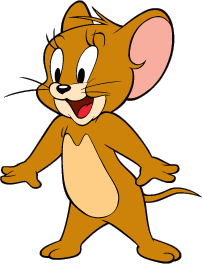Jerry Mouse
| Jerry Mouse | |
|---|---|
| Tom and Jerry (WB/Turner Entertainment) character | |

Jerry's design in the Hanna-Barbera shorts.
|
|
| First appearance |
Puss Gets the Boot (as Jinx) February 10, 1940 The Midnight Snack (as Jerry) July 19, 1941 |
| Created by | |
| Voiced by |
|
| Information | |
| Species | Mouse |
| Gender | Male |
| Affiliation | Tom Cat |
| Family | Nibbles (ward/nephew) |
| Relatives |
|
Jerry Mouse is a fictional character and one of the title characters (the other being Tom Cat) in Metro-Goldwyn-Mayer's series of Tom and Jerry theatrical cartoon short films. Created by William Hanna and Joseph Barbera, Jerry is a brown anthropomorphic house mouse, who first appeared as a mouse named Jinx in the 1940 MGM animated short Puss Gets the Boot. Hanna gave the mouse's original name as "Jinx", while Barbera claimed the mouse went unnamed in his first appearance.
The name "Jerry" was chosen by MGM animator John Carr, who submitted "Tom and Jerry" as potential names for the duo after an important Loews Inc. distributor in Texas asked for follow-ups to Puss Gets the Boot. While the idea of a cat-and-mouse duo was considered shopworn by the 1940s, Hanna and Barbera decided to expand upon the standard expected hunter/prey relationship. Their Jerry Mouse, an "incurable scene stealer", served more or less as the protagonist of most of the films; instead of being a "cowering victim" of his pursuer, Tom, he took delight in besting, and often torturing, his antagonist (though sometimes, Tom is just following orders or is even just minding his own business and is antagonized by Jerry). Hanna and Barbera considered Tom and Jerry "the best of enemies", whose rivalry hid an unspoken amount of mutual respect.
In later Tom and Jerry cartoons, Jerry acquired a young ward: a small grey mouse called "Tuffy" or "Nibbles" depending upon the cartoon, who was left on Jerry's doorstep as a foundling baby in the 1946 short The Milky Waif. Jerry and Tuffy were also featured together in a sub-series of Tom and Jerry cartoons set in 17th century France which featured the characters as musketeers. The first of these shorts, The Two Mouseketeers, won the 1951 Academy Award for Best Short Subject: Cartoons.
...
Wikipedia
